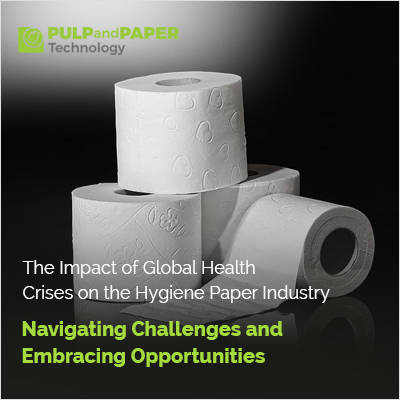The Impact of Global Health Crises on the Hygiene Paper Industry: Navigating Challenges and Embracing Opportunities

Introduction:
The hygiene paper industry plays a crucial role in maintaining public health and well-being, particularly during global health crises. The outbreak of infectious diseases, such as the COVID-19 pandemic, has significantly affected various industries, and the hygiene paper sector is no exception. This article explores the multifaceted impact of global health crises on the hygiene paper industry, examining the challenges faced and the opportunities that have emerged in response to unprecedented demands for hygiene products.
A) Challenges Faced by the Hygiene Paper Industry:
Supply Chain Disruptions:
The hygiene paper industry has been significantly impacted by global health crises, such as the recent COVID-19 pandemic, leading to widespread disruptions in supply chains. Challenges such as lockdowns, stringent travel restrictions, and workforce shortages have created unprecedented obstacles in the production and distribution of essential raw materials for hygiene paper manufacturing. These disruptions have resulted in notable delays and increased costs throughout the supply chain, creating a formidable barrier for the industry to meet the heightened demand for hygiene products. Addressing these challenges necessitates innovative solutions and strategic adaptations within the hygiene paper sector to ensure the seamless flow of crucial products to consumers.
| Read More: Advancements in Hygiene Products for the Pulp and Paper Industry |
Increased Demand and Shortages:
The hygiene paper industry has found itself grappling with a surge in demand for essential products, such as tissues, toilet paper, and sanitary napkins, during global health crises like the COVID-19 pandemic. This heightened demand has strained the industry's production capacities, creating a delicate balance between supply and consumer needs. The phenomenon of panic buying and stockpiling during health crises further exacerbates the shortages, posing considerable challenges for the industry in maintaining sufficient inventory levels and ensuring pricing stability. The industry's ability to respond effectively to this demand surge becomes pivotal, requiring strategic planning and adaptability to meet the needs of consumers while addressing the complexities arising from market dynamics during times of crisis.
| Also Read: Hygiene Essentials: Innovations in Paper-Based Hygiene Products |
Workforce Challenges:
The production of hygiene paper relies heavily on a skilled workforce, and the continuous impact of global health crises, notably the persistent COVID-19 pandemic, poses significant challenges in this regard. These crises often result in labor shortages within the hygiene paper manufacturing sector due to factors such as employee illnesses, quarantine measures, and restrictions on movement implemented to curb the spread of the disease. The health crisis directly affects the workforce, making it a top priority for companies in the hygiene paper industry to maintain a healthy and efficient workforce. Balancing the well-being of employees with sustaining operational capabilities to meet the increasing demand for essential hygiene products becomes a crucial challenge. To tackle these challenges, companies must implement innovative strategies and safeguards to protect their workforce while navigating the complexities of a disrupted labor landscape during health crises.
B) Opportunities Arising Amidst Challenges:
Innovation in Product Development:
In the face of global health challenges, the hygiene paper industry has found opportunities for growth by embracing innovative product development. Companies within this sector are actively pursuing advancements, placing a strong emphasis on creating more sustainable and environmentally friendly hygiene paper products. This strategic shift is fueled by a recognition of changing consumer preferences, with individuals increasingly valuing both hygiene and environmental consciousness.
The industry's dedication to pioneering solutions not only tackles immediate challenges but also aligns with the global emphasis on sustainability. As companies strive to provide products that resonate with environmentally conscious consumers, this innovation in product development not only enhances the industry's adaptability but also positions it as a driver for positive change in a post-pandemic world.
Digital Transformation:
Faced with disruptions in the supply chain due to global health crises, the hygiene paper industry has proactively embraced digital transformation as a strategic response. Recognizing the need for enhanced efficiency and adaptability, companies in this sector are leveraging digital technologies to address the current challenges. Digital platforms play a pivotal role in functions such as inventory management, production planning, and communication with suppliers.
Through the integration of these technologies into their operations, companies can streamline processes, gain real-time insights, and optimize resource allocation. This enables them to respond more effectively to the dynamic conditions of the market. This shift towards digitalization not only addresses immediate challenges but also positions the hygiene paper industry to be more resilient and competitive in the evolving landscape of global business.
Increased Investments in Automation:
In response to the workforce challenges exacerbated by global health crises, the hygiene paper industry has strategically turned to increased investments in automation. Recognizing the limitations posed by labor shortages due to illness, quarantine measures, or movement restrictions, companies within the sector are embracing robotics and automation technologies as key solutions. These investments are not only instrumental in addressing immediate workforce challenges but also contribute to enhancing overall production efficiency. Automation streamlines manufacturing processes reduces dependency on manual labor, and ensures consistent output. Beyond mitigating the impact of health crises on workforce availability, this strategic shift towards automation positions the hygiene paper industry for long-term sustainability by optimizing costs and improving operational resilience in the face of dynamic market conditions.
Supply Chain Diversification:
Recognizing the vulnerability of global supply chains to disruptions during health crises, companies within the hygiene paper industry are actively reevaluating their strategies and embracing supply chain diversification as a pivotal approach. This entails a shift towards sourcing materials from multiple suppliers and establishing resilient supply networks. To mitigate the impact of global disruptions, companies are building partnerships with local suppliers, thus reducing dependence on centralized sources. Additionally, investments in redundancy measures are being made to create backup systems and alternatives that can be swiftly activated in times of crisis. By adopting these proactive measures, the hygiene paper industry not only enhances its ability to withstand global disruptions but also fortifies its supply chain, ensuring a more robust and adaptable framework that can navigate unforeseen challenges with greater resilience.
Conclusion:
Amidst global health crises, the hygiene paper industry has confronted significant challenges, revealing its resilience and adaptability. In addressing immediate hurdles, the sector is actively embracing opportunities for innovation, digital transformation, and sustainable practices to respond to ongoing infectious diseases worldwide. This forward-thinking strategy not only caters to the heightened demand for essential products but also strategically situates the hygiene paper sector for long-term success in the ever-evolving global landscape.








